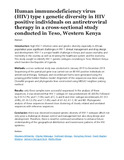Human immunodeficiency virus (HIV) type 1 genetic diversity in HIV positive individuals on antiretroviral therapy in a cross-sectional study conducted in Teso, Western Kenya
Date
2021-04-07Author
Adhiambo, Maureen
Makwaga, Olipher
Adungo, Ferdinard
Kimani, Humphrey
Mulama, David Hughes
Korir, Jackson Cheruiyot
Mwau, Matilu
Metadata
Show full item recordAbstract
Introduction: high HIV-1 infection rates and genetic diversity especially in African population pose significant challenges in HIV-1 clinical management and drug design and development. HIV-1 is a major health challenge in Kenya and causes mortality and morbidity in the country as well as straining the healthcare system and the economy. This study sought to identify HIV-1 genetic subtypes circulating in Teso, Western Kenya which borders the Republic of Uganda.
Methods: a cross-sectional study was conducted in January 2019 to December 2019. Sequencing of the partial pol gene was carried out on 80 HIV positive individuals on antiretroviral therapy. Subtypes and recombinant forms were generated using the jumping profile hidden Markov model. Alignment of the sequences was done using ClustalW program and phylogenetic tree constructed using MEGA7 neighbor-joining method.
Results: sixty three samples were successful sequenced. In the analysis of these sequences, it was observed that HIV-1 subtype A1 was predominant 43 (68.3%) followed by D 8 (12.7%) and 1 (1.6%) each of C, G and B and inter-subtype recombinants A1-D 3 (4.8%), A1-B 2 (3.2%) and 1 (1.6%) each of A1-A2, A1-C, BC and BD. Phylogenetic analysis of these sequences showed close clustering of closely related and unrelated sequences with reference sequences.
Conclusion: there was observed increased genetic diversity of HIV-1 subtypes which not only pose a challenge in disease control and management but also drug design and development. Therefore, there is need for continued surveillance to enhance future understanding of the geographical distribution and transmission patterns of the HIV epidemic.
URI
https://doi.org/10.11604/pamj.2021.38.335.26357https://www.panafrican-med-journal.com/content/article/38/335/full/
http://ir-library.mmust.ac.ke:8080/xmlui/handle/123456789/1931
Collections
- Gold Collection [1026]

